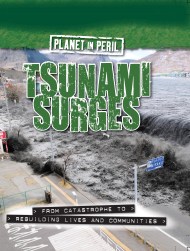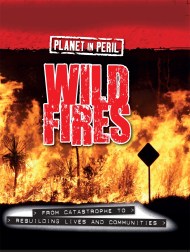Extreme weather dominates news bulletins around the world. From tsunamis to superstorms, floods to wild fires, natural disasters affect people globally on a daily basis.
Superstorms, and their deadly consequences, have hit the headlines over the past decade as hurricanes, cyclones and typhoons have devastated countries around the world. But why are these occurrences so frequent and destructive? And what happens to the affected communities after disaster has struck?
Planet in Peril: Superstorms answers these questions and many more, the different types of superstorm, what causes them and how technology is helping people to prepare for them.
The book looks at three of these natural disasters from recent years in detail: Hurricane Katrina, that struck the USA in 2004, Typhoon Bopha, that hit the Philippines in 2012, and Superstorm Sandy, that devastated the Caribbean and the USA in 2012.
Comprehensive case studies cover when and where each storm struck, the immediate impact of the disaster, the long-term effects, the global aid efforts and the rebuilding and regeneration of affected communities.
Eyewitness panels give firsthand accounts of the disaster from survivors, emergency service personnel, aid workers and scientists working to combat the effects of natural disasters.
Infographic elements display statistics about each storm in a clear, concise and visual way.
Learn about the preparations made for superstorms: what protective mechanisms and warning systems are in place, the emergency drills people must learn, and how communities are evacuated in the event of a disaster.
Find out about the disaster recovery effort immediately after each event, how aid reaches affected areas, and where it comes from.
See how communities fare in the immediate aftermath, how they cope with damage to infrastructure and homes, lack of basic necessities and, in some cases, the loss of friends or relatives. Then find out how they cope long-term, deal with the economic impact, and regenerate.
Discover if climate change and global warming are increasing the impact of superstorms, and how research is being done, and technology developed, to combat them. See how storm tracking systems and evacuation drills can dramatically improve people’s chances of survival, and how storm shutters, storm doors and storm windows can help people to protect their homes.
Planet in Peril: Superstorms is ideal for children age 9+, for geography and science projects, or simply for anyone interested in finding out the background behind the ‘extreme weather’ news reports.
Superstorms are not the only natural disaster our planet faces, find out about tsunamis, floods and wild fires in other titles in the series.
Superstorms, and their deadly consequences, have hit the headlines over the past decade as hurricanes, cyclones and typhoons have devastated countries around the world. But why are these occurrences so frequent and destructive? And what happens to the affected communities after disaster has struck?
Planet in Peril: Superstorms answers these questions and many more, the different types of superstorm, what causes them and how technology is helping people to prepare for them.
The book looks at three of these natural disasters from recent years in detail: Hurricane Katrina, that struck the USA in 2004, Typhoon Bopha, that hit the Philippines in 2012, and Superstorm Sandy, that devastated the Caribbean and the USA in 2012.
Comprehensive case studies cover when and where each storm struck, the immediate impact of the disaster, the long-term effects, the global aid efforts and the rebuilding and regeneration of affected communities.
Eyewitness panels give firsthand accounts of the disaster from survivors, emergency service personnel, aid workers and scientists working to combat the effects of natural disasters.
Infographic elements display statistics about each storm in a clear, concise and visual way.
Learn about the preparations made for superstorms: what protective mechanisms and warning systems are in place, the emergency drills people must learn, and how communities are evacuated in the event of a disaster.
Find out about the disaster recovery effort immediately after each event, how aid reaches affected areas, and where it comes from.
See how communities fare in the immediate aftermath, how they cope with damage to infrastructure and homes, lack of basic necessities and, in some cases, the loss of friends or relatives. Then find out how they cope long-term, deal with the economic impact, and regenerate.
Discover if climate change and global warming are increasing the impact of superstorms, and how research is being done, and technology developed, to combat them. See how storm tracking systems and evacuation drills can dramatically improve people’s chances of survival, and how storm shutters, storm doors and storm windows can help people to protect their homes.
Planet in Peril: Superstorms is ideal for children age 9+, for geography and science projects, or simply for anyone interested in finding out the background behind the ‘extreme weather’ news reports.
Superstorms are not the only natural disaster our planet faces, find out about tsunamis, floods and wild fires in other titles in the series.
Newsletter Signup
By clicking ‘Sign Up,’ I acknowledge that I have read and agree to Hachette Book Group’s Privacy Policy and Terms of Use





